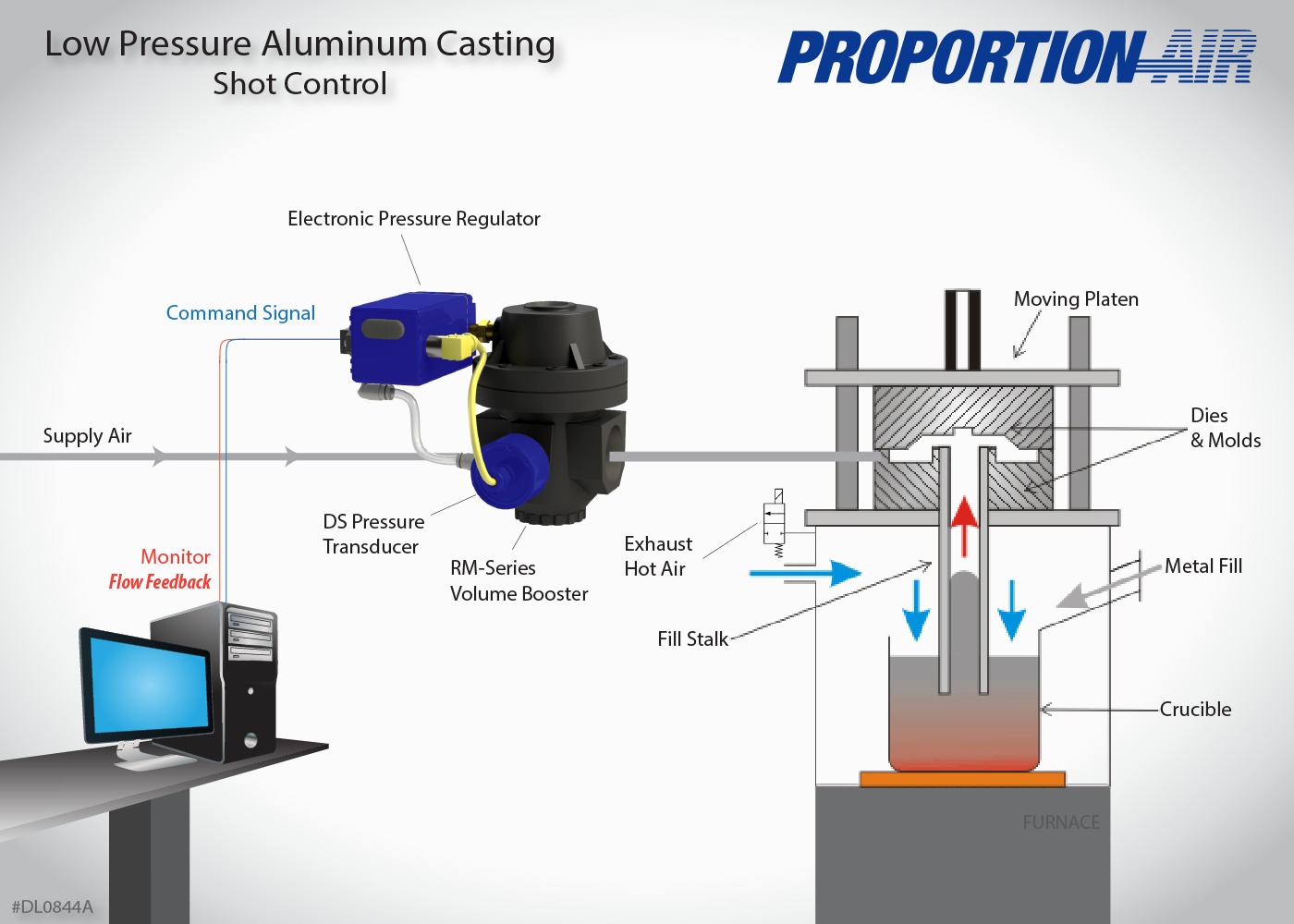Aluminum Foundry Wisconsin fuels growth in casting technologies
How Aluminum Foundry Contributes to Innovations in Aerospace Design
Aluminum factories are important to developments in aerospace design. They create light-weight, high-strength elements that are vital for contemporary airplane. With innovative spreading strategies, these factories create complicated geometries that improve structural honesty. Furthermore, the development of exceptional Aluminum alloys sustains the industry's emphasis on gas efficiency and sustainability. However, obstacles stay in the production process. Recognizing these variables exposes the extensive impact of Aluminum on aeronautics's future.
The Significance of Lightweight Products in Aerospace Design
As the aerospace industry proceeds to progress, the significance of light-weight materials becomes progressively apparent. The demand for performance and sustainability drives designers to focus on making use of materials that minimize total weight without compromising structural honesty. Lightweight materials, particularly Aluminum, play a vital role in enhancing fuel efficiency, enhancing payload capability, and raising the general performance of airplane.
Furthermore, the combination of these products permits ingenious layouts, allowing manufacturers to produce even more aerodynamic forms that can hold up against severe problems. The reduction in weight not just reduces operational costs but additionally adds to a reduced ecological footprint, lining up with worldwide initiatives towards sustainability in aviation.
Advanced Casting Techniques in Aluminum Foundries
Advanced spreading methods in Aluminum shops play a crucial duty in aerospace design by allowing the production of specific and light-weight components. Advancements in mold layout and precision casting procedures are vital in accomplishing ideal efficiency and structural stability. In addition, the growth of light-weight alloys boosts the general efficiency and efficiency of aerospace applications.
Ingenious Mold Design
Innovative mold layout plays a necessary role in the efficiency and effectiveness of Aluminum foundries, particularly within the aerospace industry. By leveraging advanced products and methods, contemporary mold and mildews can be engineered to endure heats and stress, making certain peak efficiency during the spreading procedure. These designs typically incorporate intricate geometries that permit the production of lightweight yet structurally sound components, important for aerospace applications. In addition, the use of computer-aided layout (CAD) software assists in precise modeling, making it possible for factories to fine-tune and replicate mold and mildew designs prior to physical manufacturing starts. This not only boosts the high quality of actors components but additionally minimizes waste and preparation, bring about considerable cost financial savings. On the whole, ingenious mold style is a foundation of progress in Aluminum Foundry technology for aerospace design.
Precision Casting Procedures
The performance of cutting-edge mold and mildew designs perfectly integrates with accuracy casting processes, which are necessary for generating high-grade Aluminum elements in aerospace engineering. These processes, consisting of sand casting, pass away spreading, and financial investment casting, ensure the production of complicated geometries with limited tolerances. Advanced techniques like vacuum cleaner spreading and pressure pass away casting boost the stability and surface finish of the end products. Precision spreading minimizes material waste while maximizing the mechanical homes of Aluminum, crucial for aerospace applications. Furthermore, employing real-time tracking and progressed simulation devices throughout the casting process permits for immediate changes, bring about improved quality assurance. Collectively, these accuracy spreading procedures placement Aluminum shops at the center of aerospace innovation, supporting the industry's need for integrity and performance.
Light-weight Alloy Development
As aerospace designers seek to boost gas effectiveness and performance, light-weight alloy advancement ends up being a vital emphasis in Aluminum shops. These shops utilize innovative casting methods to develop alloys that offer remarkable strength-to-weight ratios. Advancements in alloy make-up, consisting of the consolidation of components like lithium and magnesium, enable the production of products that stand up to extreme conditions while decreasing general airplane weight. Strategies such as die casting and financial investment spreading help with the accuracy production of complicated forms, which are crucial for aerospace applications. In addition, continuous research study aims to enhance these alloys for enhanced mechanical residential properties and boosted durability. By prioritizing light-weight alloy development, Aluminum foundries greatly contribute to the development of aerospace engineering, leading the way for much more reliable and sustainable aircraft styles.

Enhancing Structural Honesty Via Aluminum Elements
Aluminum components offer considerable advantages in enhancing structural honesty within aerospace design. Their light-weight nature contributes to total efficiency while keeping toughness, which is important for aircraft efficiency. Additionally, the stress and anxiety resistance properties of Aluminum aid assure the longevity and integrity of aerospace structures under various functional conditions.
Lightweight Product Benefits
While traditional products typically compromise weight for toughness, utilizing Aluminum parts in aerospace engineering provides considerable benefits in structural honesty. Aluminum's lightweight nature adds to general style effectiveness, permitting for more structured aircraft that take in less fuel, thereby enhancing sustainability. The material's excellent strength-to-weight proportion warranties that parts maintain sturdiness without adding unneeded mass. This high quality promotes boosted performance and dexterity in trip, in addition to optimized haul capacities. In addition, Aluminum's resistance to rust extends the life-span of aerospace structures, reducing maintenance prices and boosting safety and security. As suppliers increasingly take on Aluminum alloys, the aerospace market experiences a transformative shift towards a lot more effective and efficient design services that prioritize both efficiency and ecological responsibility.
Stress Resistance Characteristics
Various products possess one-of-a-kind informative post buildings, Aluminum's phenomenal tension resistance stands out as a critical aspect in enhancing the architectural integrity of aerospace parts. This resistance plays an important role in making sure that aircraft can hold up against numerous functional tensions, consisting of fatigue, influence, and ecological conditions. Aluminum alloys, specifically engineered for aerospace applications, display high tensile toughness while maintaining lightweight characteristics, allowing designers to make more effective frameworks - Aluminum Foundry. In addition, the ability of Aluminum to withstand cyclic loading without considerable contortion adds to the durability and dependability of aerospace parts. As developments continue in Aluminum Foundry methods, the development of stress-resistant Aluminum components promises further improvements in efficiency, safety, and effectiveness throughout the aerospace market, solidifying Aluminum's function as a recommended product in modern-day design
Gas Efficiency Improvements Driven by Aluminum Innovations
As the aerospace industry seeks to improve gas effectiveness, innovative uses Aluminum have actually become an important solution. Aluminum's light-weight nature significantly lowers aircraft weight, permitting lower gas consumption during flight. This reduction in weight is vital, as also small decreases can lead to substantial enhancements in general fuel economy.
Advanced Aluminum alloys, made for boosted toughness and sturdiness, allow producers to create parts that preserve architectural stability while minimizing mass - Aluminum Foundry. In addition, the combination of Aluminum in airframes and engine elements facilitates boosted aerodynamics, contributing to lowered drag and boosted effectiveness
The adoption of Aluminum in aerospace not just meets the need for fuel-efficient style yet also lines up with regulative stress for lower discharges. As these innovations proceed to advance, they play a considerable role in establishing new criteria for gas efficiency, making certain that the aerospace market can satisfy expanding economic and environmental obstacles.

The Duty of Aluminum in Sustainable Aviation Practices
The increasing emphasis on sustainable air travel methods has positioned Aluminum as a necessary material in the quest for greener aircraft layout. Recognized for its light-weight residential properties, Aluminum substantially minimizes aircraft weight, leading to reduced gas consumption and discharges. Its recyclability better improves its sustainability profile, as Aluminum can be reused indefinitely without loss of quality. This particular supports a round economic climate within the aviation field, lessening waste and resource exhaustion.
Furthermore, advancements in Aluminum alloys have actually improved their toughness and rust resistance, permitting for longer service life and reduced maintenance demands. These technologies assist in the growth of more effective aircraft frameworks, adding to total sustainability efforts. Furthermore, Aluminum's thermal conductivity plays an essential function in energy-efficient layouts, enhancing systems such as warm exchangers. Jointly, these qualities emphasize Aluminum's pivotal role ahead of time lasting air travel, lining up with international campaigns targeted at reducing the environmental influence of flight.
Challenges Faced by Aluminum Foundries in Aerospace Manufacturing
While Aluminum factories play a crucial role in aerospace manufacturing, they face significant challenges that can affect production effectiveness and top quality. One significant obstacle is the stringent check my source top quality control criteria required in the aerospace industry. Any kind of issue can endanger safety and security and efficiency, requiring extensive examination procedures that extend manufacturing timelines. In addition, shops commonly emulate changing raw material costs, which can impact prices and success. The complexity of Aluminum alloys used in aerospace applications additional complicates the production process, as precise formulas are crucial for attaining wanted mechanical homes. Furthermore, skilled labor scarcities hinder the capacity to maintain top notch manufacturing levels. Ecological regulations enforce restrictions on exhausts and waste administration, requiring factories to invest in lasting practices, which can be cost-prohibitive. These variables collectively develop a landscape where Aluminum foundries must constantly adapt to fulfill the progressing needs of aerospace production while ensuring security and conformity.
Future Trends in Aluminum Applications for Aerospace Engineering
With innovations in technology and boosting needs for performance, the future of Aluminum applications in aerospace engineering is poised for significant change. The assimilation of cutting-edge Aluminum alloys and composites is expected to enhance strength-to-weight ratios, resulting in even more fuel-efficient airplane designs. Furthermore, developments in additive manufacturing strategies will certainly allow for the production of complicated Aluminum frameworks that were formerly impossible, enhancing performance and reducing waste.

Sustainable techniques will play a crucial function, with an expanding emphasis on recycling Aluminum to decrease environmental influence. The aerospace industry is most likely to embrace smarter producing procedures, such as automation and synthetic intelligence, making sure better and accuracy in Aluminum components. In addition, collaborations in between Aluminum shops and aerospace companies will certainly cultivate research and advancement, leading the way for brand-new applications that meet the rigid requirements of contemporary aerospace engineering - Aluminum Foundry. On the whole, the future looks promising for Aluminum's role fit the skies
Regularly Asked Inquiries
What Are the Ecological Effects of Aluminum Manufacturing in Aerospace?
The ecological effects of Aluminum manufacturing in aerospace consist of significant energy consumption, greenhouse gas exhausts, and habitat disruption. Additionally, mining processes can cause dirt deterioration and water contamination, increasing concerns regarding sustainability and ecological equilibrium.
How Does Aluminum Compare to Other Materials in Aerospace Applications?
Aluminum supplies an one-of-a-kind combination of lightweight residential or commercial properties, rust resistance, and cost-effectiveness contrasted to various other products. Its high strength-to-weight proportion makes it especially helpful for aerospace applications, enhancing fuel effectiveness and total efficiency in airplane style.
What Credentials Do Aluminum Foundry Workers Need for Aerospace Projects?
Aluminum Foundry workers call for customized training in metallurgy and spreading techniques, along with understanding of aerospace market standards. Qualifications in quality control and security methods are also necessary to assure compliance with stringent aerospace project demands.
Exist Any Kind Of Safety And Security Interest In Using Aluminum in Aerospace Design?
Safety and security concerns pertaining to Aluminum in aerospace design include vulnerability to rust, anxiety, and tiredness cracks. Proper therapy and alloy choice are necessary to mitigate these risks, ensuring architectural honesty and total security in aerospace applications.
Exactly How Does Aluminum Recycling Advantage the Aerospace Market?
Aluminum recycling greatly profits the aerospace market by decreasing product expenses, reducing environmental influence, and saving power. This sustainable practice enhances the industry's effectiveness while promoting making use of light-weight, high-performance components in airplane manufacturing.
Advanced casting techniques in Aluminum factories play an essential role in aerospace design by enabling the manufacturing of exact and lightweight parts. Cutting-edge mold design plays a crucial role in the effectiveness and efficiency of Aluminum foundries, especially within the aerospace industry. As aerospace designers look for to enhance gas performance and efficiency, lightweight alloy development comes to be a crucial focus in Aluminum foundries. Aluminum alloys, specifically crafted for aerospace applications, display high tensile toughness while keeping light-weight attributes, making it possible for engineers to great post to read create much more efficient frameworks. Collaborations between Aluminum shops and aerospace firms will certainly cultivate research study and advancement, paving the means for brand-new applications that fulfill the strict demands of modern aerospace engineering.